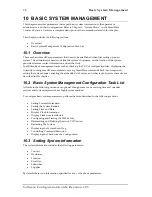
64
Configuration File Handling
9 CONFIGURATION FILE HANDLING
This chapter describes how to up- and download configuration files from and to a SmartNode 1000
or 2000 series devices. A configuration file is a batch file of SmartWare commands that are used
within the software modules that are performing specific functions of the SmartNode. Some aspects
of configuration file management are also described in this chapter. Refer to Chapter 4,
“Administrator Execution Mode” in the SmartWare
Command Reference Guide
for a complete
description of the commands related to this chapter. See also Chapter 8, “System Image Handling”,
of this document.
This chapter includes the following sections:
•
Introduction
•
Factory Configuration
•
Warnings
•
Configuration File Handling Task List
9.1 Introduction
All Inalp Networks SmartNode devices are shipped with a factory configuration file which is stored
in the flash memory of the SmartNode.
A configuration file is like a script file containing SmartWare commands that can be loaded into the
system. Configuration files may also contain only partial configurations. This allows you to keep a
library of command sequences that you may want to use as required. By default the system
automatically loads the factory configuration from the flash memory if no user-specific configuration
is defined as the startup configuration.
Changing the current running configuration is possible as follows:
•
You may change the running configuration interactively. Interactive configuring requires
that you access the CLI using the
enable
command to enter administrator execution mode.
Then you must switch to the configuration mode by typing the command
configure
. Once in
configuration mode you can enter the configuration commands that are necessary to
configure your SmartNode.
•
You can also create a new configuration file or modify an existing one offline. Configuration
files can be copied from the SmartNode flash memory to a remote server. Transferring
configuration files between the flash memory and a remote system requires the trivial file
transfer protocol (TFTP). The TFTP server must be reachable through one of the SmartNode
network interfaces.
See Chapter 6, “Accessing the SmartWare Command Line Interface”, of this document for
information concerning access to the CLI.
In the following sections the emphasis is on SmartWare memory regions and on software
components that can be copied within the memory or be up/downloaded between a TFTP server and
the memory of the SmartNode. Since SmartWare uses a specific vocabulary in naming those software
components, refer back to Chapter 1, “Terms and Definitions”, to ensure that you understand the
concepts. Moreover re-read Chapter 8, “System Image Handling”, for a basic understanding of how
SmartWare uses system memory.
Software Configuration Guide, Revision 1.03
















































